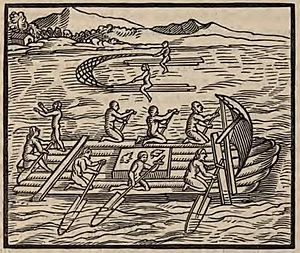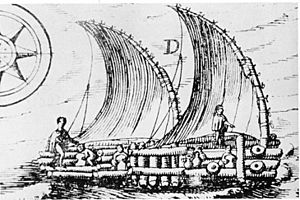Pre-Columbian rafts facts for kids
Long ago, before Christopher Columbus arrived in the Americas, people in South America used special boats called Pre-Columbian rafts. These rafts sailed along the Pacific Coast for trading goods, starting around 100 BCE or even earlier. Spanish explorers in the 1500s saw these rafts in Peru and Ecuador. They were amazed by how skilled the Native American sailors were and how well their rafts handled the ocean.
No ancient rafts have survived, so we don't know exactly how they were built or how far they traveled. However, it's thought that traders used these rafts, made from lightweight balsa wood, to sail all the way to Mexico. They might have even brought the knowledge of working with metals (metallurgy) to the people there. Some adventurers, like Thor Heyerdahl, have even sailed rafts like the famous Kon-Tiki across the Pacific Ocean. They believe ancient rafts could have traveled thousands of miles to places like Polynesia. Many others have also built similar rafts and sailed across the Pacific.
The word "balsa" actually means "raft" in Spanish. People continued to use these rafts for trade along the coasts of Peru and Ecuador until the late 1800s. This was long after the Spanish took over the Inca Empire.
Contents
First Look at Ancient Rafts
In 1526, a Spanish ship led by Bartolomé Ruiz was exploring the west coast of South America. This was the first time a ship from the "Old World" (Europe) had explored this area. Off the coast of Ecuador, Ruiz's crew saw a Native American raft. This was the first time the Spanish met people connected to the Inca Empire.
A person who was there wrote about what happened:
The Spanish captured a raft with about 20 men. Eleven of them jumped into the water. Ruiz let the rest of the crew go ashore, but he kept three to help them understand each other. He treated them well. The raft could carry up to 25 metric tons of cargo. Its bottom was made of thick balsa logs tied together with ropes. It had a top deck made of lighter canes, also tied with ropes. The people and their cargo stayed dry on the top deck, even though the bottom logs were in the water. The raft had strong wooden masts and cotton sails, just like Spanish ships. It also had good ropes and stone weights for anchors.
Another writer, Francisco de Xerez, said the raft carried "silver objects, crowns, bands, tweezers, and bells." These items were traded for special seashells. Other writers added that the rafts were very safe because they couldn't sink or flip over. Water could simply wash through them.
How Rafts Were Built and Sailed
Balsa Wood Logs
Balsa trees grow in tropical forests and have very light, large logs. These logs can be up to 90 centimeters (about 3 feet) wide. Balsa trees didn't grow naturally on the dry coasts of Peru and southern Ecuador. So, the logs for the rafts came from the Guayas River valley in Ecuador. This area is still a main source of balsa wood today.
Some people wondered if balsa logs would soak up too much water and sink on long trips. But in 1947, Thor Heyerdahl used green balsa logs for his Kon-Tiki voyage. His raft stayed afloat for 101 days! Other studies have also shown that dry balsa logs can float for a long time.
Rafts were always built with an odd number of balsa logs, usually from 3 to 11. The middle log was the longest, and the others got shorter on each side. The Spanish said the rafts looked like an open hand with fingers spread out. These large balsa logs were tied together with strong plant fibers. Water could easily pass between and over the logs, which meant the rafts wouldn't be swamped by big waves.
On top of the main balsa logs, there was a platform made of cane or bamboo. This platform kept the cargo and passengers dry. In ancient times, this platform might even have had a small hut for shelter and a fire pit for cooking.
Sails and Masts
Some experts have wondered if ancient rafts really used sails, or if the Spanish introduced them. However, the writer who described Ruiz's voyage in 1526 clearly said the raft had sails. This was only 13 years after the Spanish first saw the Pacific Ocean. Another writer from that time said sails had been used on rafts "since time immemorial" (for a very long time).
There's also a debate about whether the sails were square or triangular. Early reports describe triangular sails, probably two of them, one at the front and one at the back, on two masts. Studies suggest the masts were curved and about 7.5 meters (25 feet) long. They might have been made of two pieces of wood joined together. Today, people building replica rafts often use mangrove wood, which is common along the coasts of Ecuador and northern Peru.
How Rafts Were Steered
Pre-Columbian rafts were steered using sails and special boards called "guaras." These were wooden boards, about 60 centimeters (2 feet) wide, placed vertically between the balsa logs in the water. Larger rafts had three sets of guaras: at the front, back, and middle. By raising, lowering, or moving these boards, sailors could change how the raft moved through the water. This allowed them to steer the raft very well.
Working with the sails, the guaras allowed the crew to perform "all the maneuvers of a regularly built and well-rigged vessel." These rafts could reach speeds of 4 to 5 knots (about 7 to 9 kilometers per hour or 4 to 6 miles per hour).
Size and What They Could Carry
Studies show that ocean-going rafts were usually 6 to 11 meters (20 to 36 feet) long. They could carry 10 to 30 tons of cargo. However, as the balsa logs soaked up seawater, the raft's carrying capacity went down. After 4 months in the water, the largest rafts could only carry 10 tons. After 8 months, they could only carry 5 tons. This meant a raft could be used for about 8 months before it became too waterlogged.
Trading with Mexico
We don't know exactly how long people have used sea-going rafts on the coasts of Ecuador and Peru. This is because ancient balsa wood rafts don't leave many traces for archaeologists to find. But it seems that a trading system along the coast, from southern Colombia to northern Chile, was in place by about 100 BCE. There were two main trading centers: the northern coast of Ecuador and the Chincha culture area in Peru.
Around 800 CE, people in Mexico suddenly started using metallurgy (working with metals). Archaeologists believe this skill was brought to Mexico by sea-going rafts from the Ecuadorian coast. People in Ecuador had been working with metals for hundreds of years already. Later, after 1200 CE, metalworking in Mexico became very similar to the methods used by the Chincha people in Peru.
Experts have figured out that a one-way trip from Ecuador to Mexico would have taken six to eight weeks. This is based on sailing about 12 hours a day at an average speed of 4 knots. To have the best weather, traders would likely leave Ecuador in early December and arrive in Mexico in late January. They would start their return trip in early March and get back to Ecuador in early May. A raft could make two round trips before getting too waterlogged. Some sailors might stay longer in Mexico. One Spanish report from 1525 said that "Indians from certain islands in the south...brought amazing products which they would trade for local products and...stay for five or six months until good weather occurred." It was during these trade trips that South American sailors might have shared their metalworking skills with Mexico.
The trade between Ecuador and Mexico involved luxury items. These included Spondylus (spiny oyster) and Strombus (conch) shells. These shells were very important and were traded from their warm ocean homes in Ecuador all over the Andes mountains and up and down the coasts of South America.
Modern Raft Journeys
Since the Kon-Tiki raft sailed in 1947, many people have crossed the Pacific Ocean by raft, traveling from South America to Polynesia. In the 1990s, four attempts to sail a raft from Ecuador to Mexico didn't quite make it, though one reached Costa Rica. These modern voyages have shown that ancient rafts were indeed seaworthy. As an early Spaniard said, the Native Americans who sailed them were "great mariners" (skilled sailors). Even after the Spanish arrived, they relied on the Native Americans and their rafts for coastal trade in Peru and Ecuador from the 1500s to the 1800s.
|




